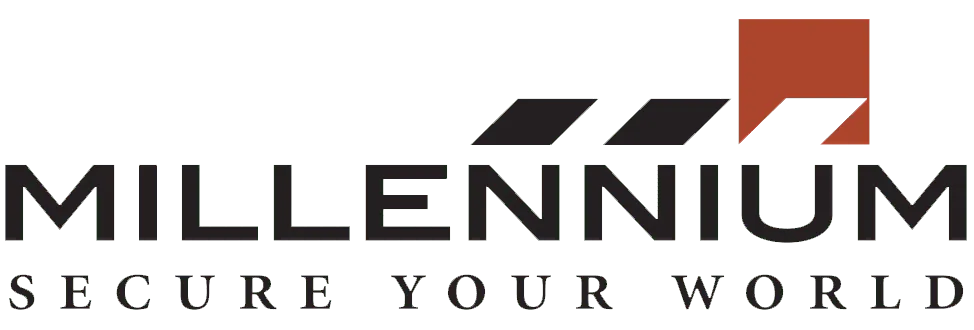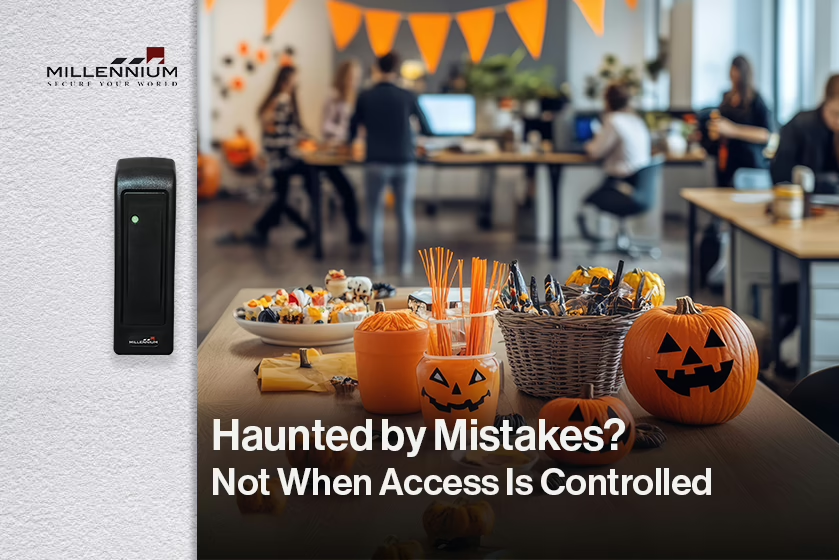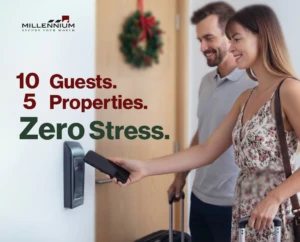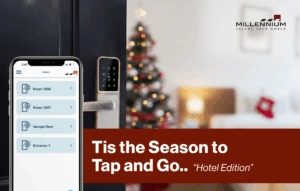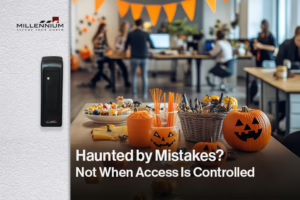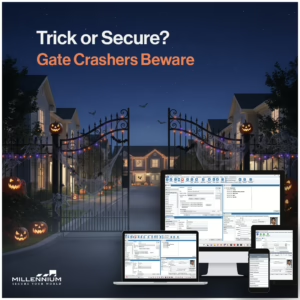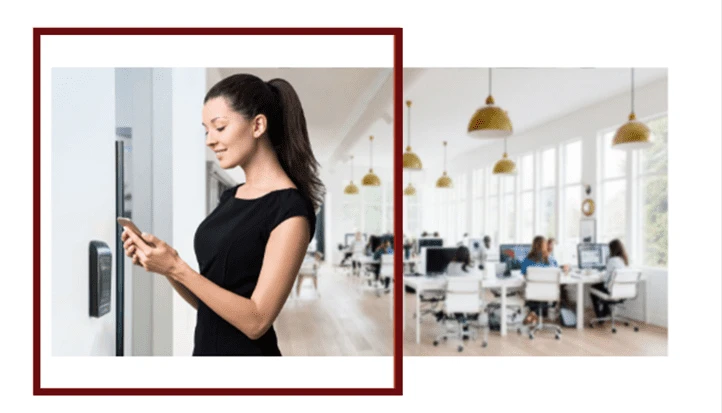Halloween night is full of spooky surprises —some harmless, others not so much. Between trick-or-treaters, after-hours events, and costumed chaos, security teams often find themselves reacting to situations that could have easily been avoided. From break-ins disguised as pranks to parties that spiral out of control, here are a few realistic Halloween-night security scenarios that access control could have turned into nothing more than ghost stories.
1. The Costume Party Break-In That No One Noticed
It was supposed to be a private office Halloween party — just employees and their families. But when everyone’s in costume, it’s hard to tell who’s who. Amid the laughter and music, two uninvited guests in masks wandered in unnoticed. By the time anyone realized they didn’t belong, a few laptops and personal items had vanished.
If a smart access control system had been in place, this could have been avoided. With credential-based access or temporary digital passes, only registered employees and approved guests would have been able to enter. Real-time monitoring and entry logs would have alerted facility staff to unauthorized access — preventing the “ghost guests” from slipping in at all.
Beyond access management, such systems can integrate with event registration platforms, syncing guest lists automatically to eliminate manual errors.
Notifications could be triggered the moment an unverified badge or mobile credential is used, allowing on-site teams to respond discreetly before any loss occurs. Even better, video integrations can provide visual verification — matching credentials to faces for an added layer of assurance. With access control intelligence working silently in the background, the party stays fun, festive, and secure.
2. The Haunted Hotel That Went a Little Too Dark
At a themed Halloween event in a boutique hotel, staff dimmed the lights to create a spooky atmosphere — but that also created a security blind spot. Someone slipped into a restricted maintenance corridor and tampered with the power system, plunging an entire floor into darkness. Guests panicked, and the cleanup took hours.
A cloud-based access control platform could have locked down staff-only areas automatically, ensuring only authorized personnel could enter. Integrated smart cameras would have detected unusual movement in off-limits zones, alerting security before things literally went dark.
In addition, access systems can pair with lighting and HVAC automation to maintain situational visibility during themed events. For example, doors that detect motion in unauthorized areas could temporarily trigger emergency lighting or send instant alerts to mobile dashboards.
These integrations ensure guest experiences remain immersive but safe — balancing ambiance with awareness. By combining access control with environmental monitoring, hospitality teams can host memorable experiences without the risk of a real horror story.
3. The Neighborhood Prank That Got Out of Hand
A gated community decorated for Halloween found itself the target of overzealous pranksters. Teens managed to open the side gate using an old remote, sneaking in to play “ghost” with motion sensors and yard decor. Unfortunately, their antics caused damage to several homes’ security lights and cameras.
Had the community been equipped with mobile credentials and modern gate access control, the outdated remotes would have been obsolete. Real-time access logs and alerts could have notified residents or on-site guards immediately — turning potential vandalism into a quick warning and a harmless scare.
Today’s access systems can even integrate license plate recognition (LPR) and visitor management solutions to add context to every entry event. That means if someone attempts to access the property using outdated or cloned credentials, the system can instantly flag and block it. Residents can also issue temporary guest passes for friends or deliveries, ensuring flexibility without sacrificing control. When communities combine smart technology with neighborhood awareness, security becomes an invisible shield — protecting the fun without spoiling the spirit.
4. The School That Forgot to Lock the Doors
After a fun-filled Halloween carnival, a local school closed for the night — or so they thought. Custodians left through a side entrance that didn’t latch properly. Hours later, a group of trespassers entered, filming a “ghost hunt” for social media that resulted in property damage and security risks.
An automated lock schedule with centralized door control could have secured all entry points at a set time. Even better, remote access management would have allowed administrators to verify — and if needed, lock — every door from their phones. With the right access control, the “ghost hunt” would’ve never left the parking lot.
Access systems in schools can also integrate with intrusion detection and emergency response features — automatically alerting local authorities if a breach occurs after hours. Audit trails make it easy to identify how and when an entry point was compromised. Additionally, temporary lockdown modes can be activated with a single command, instantly securing all doors during after-hours events. In the modern education environment, automation isn’t just convenient — it’s critical for ensuring student and staff safety long after the festivities end.
Download the Cloud Access Control Checklist
your 15-step, printable guide to building a secure, scalable, and cloud-ready system.
Includes: PoLP setup, MFA guide, permission audit worksheet + a bonus printable template.
5. The Retail Rush That Turned into a Scare
A downtown shopping center hosted a Halloween sale that drew record crowds. As closing time neared, a few customers hid in fitting rooms hoping to stay after hours for content creation. Staff locked up as usual, unaware that people were still inside. The motion sensors later triggered alarms, and police had to sweep the building.
Access control systems with occupancy tracking and zoned access permissions could have ensured every area was clear before lockdown. The system could automatically disable entry once the store’s occupancy limit was met, keeping the event fun — and safe — for everyone involved.
Advanced integrations now allow retailers to tie access data with video analytics and POS systems, creating a holistic view of store activity. For example, if occupancy sensors detect movement after hours, the system can trigger cameras in that exact zone, reducing false alarms. Managers can also receive instant mobile alerts when zones exceed safe capacity levels. In high-traffic retail environments, access control adds structure and accountability — ensuring busy holidays like Halloween don’t become logistical nightmares.
6. The Data Center’s Midnight Visitor
At a tech campus, Halloween decorations included spooky lights and fog machines — fun for employees, but a nightmare for the security team when motion sensors kept tripping false alarms. Amid the confusion, a delivery driver mistakenly entered a data-restricted area to “drop off props.” He had no malicious intent, but his presence violated compliance rules.
A multi-factor access system combining badge credentials with biometric checks could have stopped the mishap. Integrated AI-driven monitoring could distinguish between normal festive activity and actual unauthorized movement — protecting sensitive spaces without dampening the Halloween spirit.
In sensitive environments like data centers, even unintentional access breaches can create audit and compliance challenges. Access systems with detailed event logs and user-specific permissions make it easy to maintain accountability. These tools not only prevent physical intrusion but also align with cybersecurity policies — bridging the gap between digital and physical security. The result? Facilities that stay both compliant and celebratory, with automation guarding every door, even during moments of distraction.
Why It Matters: Every Scare Has a Lesson
Halloween amplifies every security weak point — from poor visibility to lax access policies. These scenarios may sound spooky, but they happen more often than you’d think. Each one highlights a simple truth: access control isn’t just about keeping doors locked — it’s about managing trust, timing, and transparency.
With the right tools, facilities can enjoy the fun of Halloween without fear of real fright.
At Millennium, we help businesses, schools, and communities stay protected year-round — even on the scariest night of the year. From smartphone credentials and smart cameras to cloud-based monitoring, our access solutions keep unwanted visitors out and peace of mind in. This Halloween, let the ghosts be the only ones haunting your property.
Millennium is a scalable, hosted, access control platform that services any type of real estate. Our cloud-based solution allows managers and tenants to efficiently manage their physical security from anywhere while enhancing experience and driving profitability.

